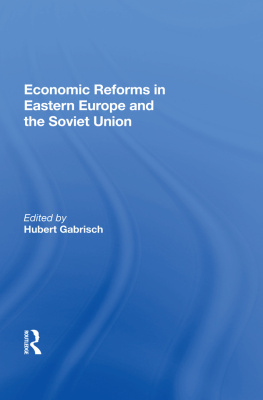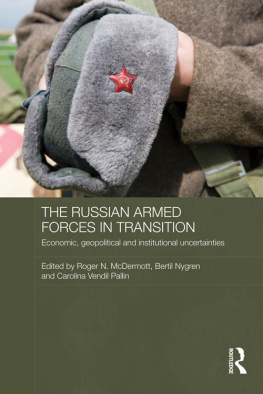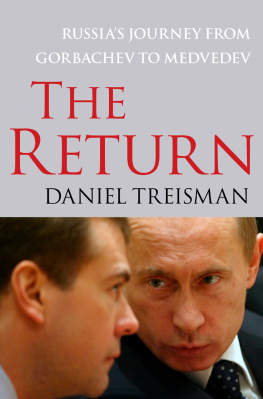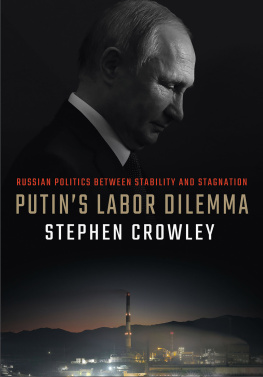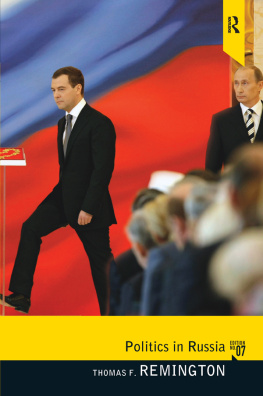Without a Map
Without a Map
Political Tactics and
Economic Reform in Russia
Andrei Shleifer
Daniel Treisman


Contents
vii
1 1 1
Preface
At the turn of the twenty-first century, there is little dispute among economists about what conditions are conducive to economic growth and prosperity. Markets should be free. Property should be private and secure. Inflation should be low. Trade between countries should not be obstructed. To achieve these goals, a country's government must leave prices alone, avoid owning or subsidizing firms, enforce contracts, regulate responsibly, balance its budget, and remove trade barriers. Any government that does all this can expect national income to grow.
When communist regimes collapsed across Europe between 1989 and 1991, the new governments that took their place were rarely short of economic advice along these lines. Some post-communist countries managed to achieve much of the desired program quickly. Others did not. We argue that the main reason was politics. While in the 1990s economic goals were similar among many transition economies, the nature of political constraints varied from country to country depending on the particular configuration of institutions and interest groups that history, geography, and past government policies had thrown up. Successful reform required not just an understanding of the elements of a market economy, but also strategies for getting around the political obstacles to building one-not just a clear view of the mountain peak in the distance, but an ability to find a path to it. We call such strategies the "how" of reform. They include tactics to divide powerful interest groups opposed to change and to coopt parts of the hostile coalition, while eliminating the ability of other opponents to block reform.
Russia between 1991 and 1998 teaches important lessons about how desirable economic changes can be made feasible despite formidable political opposition. During these years, President Yeltsin included in his governments several economic reformers. From the beginning, these reformers faced a series of powerful opponents, not only outside but also inside the government. Early on, they confronted opposition from the traditional industrial and agricultural interests left behind when the Soviet economy disintegrated. Later, powerful banks and energy companies-the very beneficiaries of earlier reforms-defended the status quo against further change. The Parliament was hostile to market reforms from the start. And throughout this period, the national government had to deal with assertions of political and economic autonomy by Russia's far-flung regions, which significantly limited the options for economic policy.
In some crucial cases, the reformers managed to get around these political obstacles. The early record includes some remarkable successes. Reformers found political tactics to complete privatization of most of state industry in just a few years. They then outmaneuvered a coalition of speculative banks and subsidized enterprises to get inflation down to manageable levels. They also failed in some significant ways. Tax reforms ground down, and public finance eroded to the point where Russia's economy faced the "Asian flu" of 1997-98 with a severely weakened immune system.
This book tells the story of the political tactics of Russia's market reforms. From Russia's experience, it seeks general insights that can be used to analyze and devise politically feasible reform programs in other places and times. Most of the information we present is widely available, but some analysis is based on our experience advising parts of the Russian government during this period. Shleifer's work focused on privatization, while Treisman provided some technical advice on tax issues and fiscal federalism. The experience helped to shape our conclusions.
In recent years, a number of books and articles have set out to evaluate Russia's reforms. Many have compared what was accomplished to a wish list of all the improvements that might be desired, or alternatively to an idealized image of a good market economy. Not surprisingly, such assessments have been extremely negative. In this book, we adopt a different standpoint. We try to compare the Russian reforms in the 1990s to the alternatives that were politically feasible at the time. We evaluate economic policies taking account of the political constraints, rather than relative to some abstract standard. For closely related reasons, this book largely eschews comparisons with other transition economies. To make such comparisons, one needs to under stand in detail the political constraints on reform in each countrywhich we feel knowledgeable enough to describe only for the case of Russia. Even for Russia, our characterization may well be amended as new historical research appears.
In the course of writing this book, we have incurred major intellectual debts. Perhaps the greatest debts are to the Russian reformers: Maxim Boycko, Anatoli Chubais, and Dmitry Vasiliev, who actually struggled with the dilemmas that we describe. Alexei Lavrov and Lev Freinkman have offered insight into the Russian fiscal system over the years. Philippe Aghion, Anders Aslund, Robert Bates, Erik Berglof, Olivier Blanchard, Robert Conrad, Stanley Fischer, Vladimir Gimpelson, Edward Glaeser, Joel Hellman, James Hines, John Litwack, Send- hil Mullanaithan, Yingyi Qian, and Gerard Roland read the manuscript and provided invaluable comments. We are also grateful to seminar participants at the European Bank for Reconstruction and Development, the International Monetary Fund, and the Russian European Center for Economic Policy. Earlier versions of parts of the argument appeared in the journals World Politics and Economics and Politics, and in a discussion paper of the OECD Development Centre, and we thank these publications for permission to revisit this material here. Deborah Treisman provided excellent editorial assistance, and Clare MacLean performed valiantly in getting the manuscript into shape.
Treisman gratefully acknowledges support from the UCLA Academic Senate and Center for European and Russian Studies, USAID, the Hoover Institution, and the Smith Richardson Foundation. Shleifer appreciates the hospitality of MIT's Sloan School of Management during the sabbatical year of 1998-99. Both authors are thankful to their very patient and good-spirited wives.
1
The Politics of Economic
Reform in Russia
In the seven years between November 1991, and August 1998, a series of Russian governments tried to enact and implement far-reaching economic reforms. Their goal was simple if daunting: to replace an order built on state ownership, central planning, and administrative control with one based on private property, market coordination, and voluntary exchange. The price mechanism would supersede the bureaucrats of Gosplan, and individual initiative would take the place of hierarchical command. Whole libraries of books and decades of history suggested that such changes would yield greater efficiency, faster growth, and more individual freedom. At the same time, reformers knew that any achievements of marketization would survive only if they were also able to create a powerful political coalition in support of free markets.
In many regards, the reforms introduced during these years were a remarkable success. Most price controls were removed in 1992 and both domestic and foreign trade were liberalized. By August 1996, monthly inflation had been brought down from the January 1992, peak of 245 percent to close to 0 percent. Exports rose from about $54 billion in 1992 to about $87 billion in 1997, and Russia ran a $20 billion trade surplus that year.' Markets for corporate shares and government bonds were created from scratch. The proportion of the work force employed in nonstate firms grew from 13 percent in 1991 to more than 60 percent by the end of 1994. As of January 1997, only 9 percent of registered enterprises were still entirely state-owned.2 And, to the surprise of many observers, Russian voters reelected Boris Yeltsin in July 1996 thereby reversing a trend of disenchantment with incumbent reformers that was evident across Eastern Europe.




